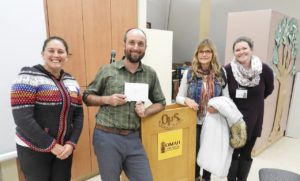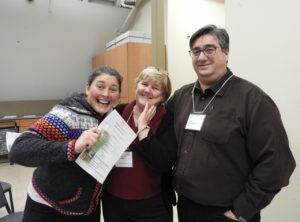On January 2nd the Orillia Naturalists were squirming in their seats as Phil Careless passed a preserved bedbug around and presented his talk on “Bizarre Interactions and Partnerships of Parasitic Invertebrates of Local Parks.”
Phil describes himself as a “Mechanic of the Environment.” He is endlessly curious about nature and the more he learns the more he wants to know. He is intrigued and fascinated how the pieces fit together.
Phil is one of eight Ontario Park Biologists and is in charge of managing The Queen Elizabeth II Wildlands, Balsam Lake and Indian Point Provincial Parks. He was born and raised in Toronto and completed an undergraduate degree in Ecology and a Master’s of Science specializing in Entomology at the University of Guelph.
Just hearing the word “parasite” makes most people cringe, but Phil is excited to observe and talk about these free-loaders. According to Phil, being a parasite is a lifestyle, as they are not a species. It is more about how they survive – that is in or on a host.
The presentation focused on life cycles of parasites found in local habitats. There were numerous examples but only a few are mentioned here.
In the rock barrens is the horsehair worm parasite. This parasite looks like a long, thin black spaghetti. A cricket will eat the eggs and the horsehair worm will hatch and mature in the cricket’s stomach. Upon maturity the horsehair worm explodes from the cricket’s belly.
Just as interesting in the wetlands, but not as deadly, is the freshwater mussel. The mussel uses a fleshy part of its body as a lure. The mussel waves its lure to attract a fish. When the fish bites, baby mussels burst out and attach themselves to the fish’s gills. The babies live on the fish’s gills until big enough to drop off and settle at the bottom of the lake.
In the mixed forest environment there was a lot of discussion on bot flies, especially the bot fly that lives in chipmunks. The adult fly lays its eggs by the entrance of the chipmunk’s nest and when the unsuspecting chipmunk runs by, the larva attach themselves. The larva then move to the genital area to burrow in, as this area has the best blood circulation. Who knew?
Phil’s advice? Sit in your canoe and observe the lily pads, crack open a gull on a golden rod or look under that leaf – you might be surprised what you find.
 |
 |
| Ann-Marie Kungl, Philip Careless, Cathy Massig, Tanya Clark |
|
 |
 |
| A dead preserved bed bug in a jar | Ann-Marie Kungi, Marilyn Clark, Denis Paccagnella |
Text submitted by Cathy Bernatavicius. Photos by Tanya Clark
